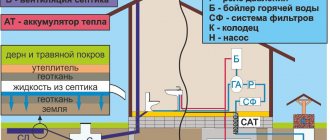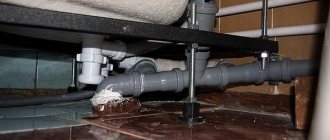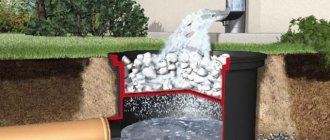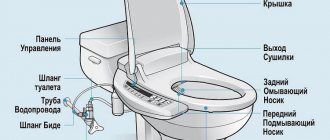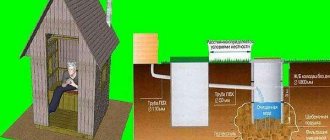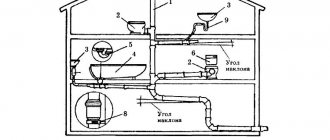Properly planned and equipped drainage system in a private house ensures a comfortable life for the owners and guarantees a long service life of the building. After all, a modern cottage is not just a structure, but a complex of interconnected systems.
Is it possible to imagine such housing without running water and sewerage? No. Therefore, a drainage project with a layout of the main components is first developed. Let's figure out together how calculation work is carried out and installation is carried out.
Definition and regulatory framework
Storm drainage, also known as rain drainage, also known as storm sewer, is a multicomponent engineering system designed to collect and drain precipitation and melt water. But if in most cases it is aimed specifically at getting rid of excess moisture, then in some situations it can also be used to obtain the missing one. When there are problems with water supply in the area, rainwater will be an excellent help. How much can actually be collected from a roof, depending on the area and level of precipitation, can be calculated exactly if desired, but there is also the result of “full-scale tests”.
GerasimForumHouse Member
My statistical patch: a roof of 100 m², a drain in four corners, one corner led into a four-cube font. A full font (from 25 m² of roof) is filled in a month. Not Moscow, but the north of the Moscow region.
And even if this water is technical and “along the way” it will pick up dust and debris, it is quite possible to use it for irrigation and other needs that do not require crystal transparency.
In a more familiar functionality, the storm drainage system of a house, together with the blind area, protects the foundation of the house and other buildings and prevents the formation of stagnant puddles. This is on sandy soils with a low groundwater level and a couple of hours after the rain there is nothing left anywhere. And on clay, and even with high water flow and in the summer, or even in the off-season, without the construction of a storm sewer there will be not a yard, but a swamp.
Although almost all existing standards are advisory in nature in relation to private sector objects, this is not a reason not to use them. Why reinvent another kind of wheel when everything has already been thought out and calculated, all that remains is to apply it. When calculating storm drainage for your country house, you need to focus on the current SP 32.13330.2018 Sewerage. External networks and structures. SNiP 2.04.03-85. At the moment, this is the latest updated edition, developed in another century and another state of rules. It applies to both those under construction and those already in operation and those being reconstructed.
Useful tips for arrangement
If there is a need to turn the pipe 90 degrees, it is better to organize two 45-degree bends. This will reduce the sharpness of the turn and create minimal resistance in the network.
If a turn of 90 degrees or more is achieved, a manhole is installed at the junction. It smoothes the turning angle and prevents clogging
It is impossible to organize drainage from the roof to the blind area. This will lead to waterlogging of the soil around the building and loss of its bearing capacity.
The surface water drainage system and foundation drainage should not be combined. Their joint work is dangerous due to rainwater entering the drainage and flooding the foundation.
Don't forget to add taps to the system that will prevent flow redirection in emergency situations or during repairs.
Types of storm systems
As on an industrial scale, two types of storm sewer systems are common in the private sphere, differing in their operating principles: point and linear.
Point storm drainage is local - it consists of several storm inlets installed under gutters and drainage systems of open or closed type. This is the most common type of storm drainage system, implemented by the majority of homeowners, since there is little good in flooding the site with every rainstorm.
Linear storm drainage is more complex - it is designed to collect and drain wastewater from the site and is somewhat reminiscent of radial drainage. The difference is that trays or open channels are installed at ground level, and drainage pipes are laid at depth. But the tasks of the systems are similar - to quickly and effectively drain water from the site and prevent stagnation and wetting of the root system of fruit and ornamental crops. Unlike a point one, a linear type storm sewer system is always individual, and its layout is tied to the topography of the site.
Septic tanks
Such non-volatile wastewater treatment systems include brands Breeze, Topbio, Kedr, Triton, Tank, Osina and many others. These devices show approximately a 50 percent cleaning rate. After treatment, the treated wastewater is discharged through an internal drainage system to filtration fields, the soil of which must be renewed every 5-7 years.
Septic tanks and their accompanying filtration fields cannot be used in areas characterized by the presence of large amounts of water, therefore, if the area is flooded or the groundwater level is high, it is better to refrain from such systems. Of course, this rule can be neglected, but the risk will not be justified: harmful microorganisms always appear in such fields, which will subsequently spread throughout the soil and infect the surrounding area, and all this action is accompanied by an extremely unpleasant odor.
Storm drain equipment
Point storm drainage is equipped with a standard set of elements.
- Storm water inlets are mostly plastic, less often concrete containers, installed directly under the drainpipe.
- Branches are specialized two-layer pipes or pipes for external sewerage, laid underground, through which wastewater is discharged outside the site or to a collection point. Bends can also be of an open type, in the form of polymer or concrete trays with gratings, homemade ones made from asbestos-cement or polymer pipes dissolved in half, or simply ditches dug in the ground.
- Water intakes - if we are talking about country cottage settlements, rural settlements or gardening partnerships, they usually have a common rainwater drainage system in the form of drainage ditches along the boundaries of the plots. In this case, the outlets discharge water outside the yard. Less often, a drainage ditch is located directly on the site, in a lowland; it can also be a functional and decorative dry stream or pond. In the absence of this, storm sewer effluent is directed to a receiving absorption (drainage) well, where it settles, filters through a layer of crushed stone and is gradually absorbed into the ground. Another option is storage storm wells, which are pumped out as accumulation occurs using special drainage pumps.
Linear storm drainage is usually performed not instead of, but together with point drainage, in order to increase the efficiency of drainage of the area. In this case, open ready-made or homemade trays are added to the rainwater inlets. They are installed along blind areas, garden paths, in the parking area and in places where water accumulates around the site.
Is it possible not to pay for sewerage, legal methods and responsibility
Of course, you will have to pay for the drainage service provided. There is no legal way to avoid this.
The management company or resource supplying organization has the right to apply sanctions to defaulters, namely:
- The law allows penalties to be charged. So, for failure to pay utility bills in the amount for the previous billing period, penalties will be charged next month. Consequently, the debt will grow every month.
- Utility companies have the right to file an application with the Magistrates' Court, and literally within 10 days it will issue a court order to collect the debt and will not even investigate. Next, the case is transferred to the bailiffs, they will forcibly collect funds from the debtor’s account. In addition to the collection, the state fee for consideration of the application by the court and the enforcement fee, at least 1000 rubles, for the work of the bailiff are subject to collection.
- Most recently, utility debt debtors were banned from leaving the country.
- Limit the supply of water and thermal energy to the apartment. Of course, utility companies will not be able to restrict water disposal for obvious reasons, but they can turn off the water.
In general, you will have to pay anyway, but it is better to do it on time and not increase the debt with penalties.
What pipes to use for stormwater drainage
For large volumes of wastewater (large roof area, rainy region), the use of only open channels is ineffective, except as additional water collectors. Therefore, rainwater drainage outlets are laid underground from each storm inlet, using polymer pipes in pedestrian load areas and metal pipes (steel, cast iron) if it is necessary to lay a highway through the entrance area. Polymer pipes are used in two types:
- Corrugated two-layer - the outer layer is made of low-density polyethylene, and the inner layer is made of high-density polyethylene. We are talking specifically about specialized pipes with a high class of rigidity, intended for the installation of storm sewers, and not about installation pipes in which electrical cables are laid.
- Red sewer - they are designed to drain gray wastewater from the house to local treatment facilities or to the collector of a centralized network. But in most cases, storm sewers are equipped with these pipes.
The volume of storm drains is a calculated value, depending both on the roof area of the building and on the amount of precipitation falling in the region, but in most cases, a pipe with a diameter of 110 mm is sufficient for storm drainage of even a large private house. In terms of cost, both corrugated and smooth PVC will cost approximately the same, but if we consider convenience and final costs, corrugated is preferable. Due to the flexibility of installation, a minimum number of fittings are required, but they also cost money, and repairs are usually required where there is a connection. The ease of laying a flexible pipe is an order of magnitude higher than that of a rigid pipe, and the corrugation holds its shape no worse. The strength class (SN) of both types is sufficient for underground installation even at great depths. Typically, storm drains are not deeply buried, but when it comes to a point system, the outlet is laid mainly under the blind area.
What to do if the amount in the receipt is more than what you need to pay
Sometimes management companies charge more than they actually should. They often do this on purpose, because not everyone checks the correctness of the accruals on the receipt form. Where to contact? What if, for example, your management company does not respond to verbal comments and questions?
- Do the calculations every time before you pay.
- If the amount on the receipt does not coincide with what you calculated, then write a statement requesting a recalculation. It is drawn up in two copies, one of them, with the incoming numbers and date of acceptance, remains in your hands.
- It is better to come in person rather than send by mail. It is reviewed within no more than 30 days.
- If the company does not respond, you can go to court. An application with an incoming mark must be attached to the claim.
The court will consider the dispute, oblige the management company to reconcile all accruals and recalculate. The latter also faces a fine.
Nuances of design and implementation of storm drainage
Like any engineering system, a storm drain needs to be calculated and designed, and whether it is a hand sketch or visualization in a graphic editor is secondary. The main condition for good conductivity of the system is compliance with the slope when laying both open channels and underground drainage. This indicator is also regulated by the current joint venture and directly depends on the diameter - for the “top” 110 mm, a slope of 2 cm is set for each linear meter of pipe. A fairly large slope is due to rapidity; if the drainage pipe operates in a constant, measured mode, collecting and removing water, then the rain pipe “rarely, but accurately” removes the pressure flow. On relatively short sections, some reduction in slope is not critical; when laying long highways, it is necessary to maintain the recommended value. Otherwise, the operation of the storm sewer during peak load may be disrupted. When calculating and designing a point storm sewer system with underground drainage, it is necessary to provide rotary wells. Otherwise, the system operation may last less than desired.
LadomirModerator FORUMHOUSE
Standards and recommendations believe, and practice confirms, that turning wells should be installed at least at every second turn. A storm drain can also be used as a turn. Failure to comply with this recommendation reduces the capital (service life) and maintainability of the system.
The rotary well can be either ready-made or home-made - from the same red pipe, the main thing is that the diameter is at least 300 mm, and better yet, even larger. But if you start a collective farm, you will have to figure out both the bottom and the lid, whereas ready-made kits can simply be attached to the pipes.
Let's consider a typical situation.
AHDPEY_RUZAFORUMHOUSE Member
Help design and implement storm drainage. I'm building a house. There is no storm drainage system. I'm very worried. This fall I bought rain receivers. Now I want to prepare for spring and start arranging the stormwater system in the spring. But I have no problem with the theory. What is the calculation, what is needed? How to connect receivers to red sewer pipes? Through a tee or in series. I have eight gutters and a slight slope of the site, relative to the picture - from bottom to top.
Instructions.
LadomirModerator FORUMHOUSE
You need eight storm inlets connected by pipes that discharge the wastewater either into an open drainage ditch or to an underground filtration structure (for example, an absorption well). Stormwater inlets have seats for connecting to pipes; usually they are connected in series, but sometimes you have to use a tee. You will also need rotary wells, we connect storm water inlets and wells with pipes and from the last storm water inlet or well we take the wastewater out for disposal. And if it is impossible to bring wastewater to the surface or into a ditch in an open way, an absorption or collection well (wells) may be needed. The slope of the system should be directed towards the slope of the terrain.
When laying pipes for a rainwater system, there is much less “dancing” with tambourines than when installing a drainage system. The depth of installation in each case is selected individually, but on average it is 30-50 cm. For many, the drainage line runs under the lawn and flower beds; this depth is enough to avoid damaging the pipes during planting and processing. Considering that stormwater is still a seasonal system with maximum load in warm seasons, installation above the freezing level is quite logical. But to be on the safe side, some throw a heating cable into the trench.
The trench itself is dug in compliance with the slope; the pros recommend digging not from the catchment to the discharge, but, on the contrary, from the well (ditch, ravine, stream, pond, etc.) upward. The pipeline is laid without preliminary preparation, directly on the ground, the trench is filled with soil, but if the soil is heaving, crushed stone is added. When installing storm water inlets under them, it is advisable to pour a concrete preparation on top of a layer of crushed stone. Some sources recommend concreting on all sides with pouring into formwork, but this is redundant. Storm water inlets are mounted in the same plane with the formwork and will be securely fixed when laying the rough layers and finishing coating even without a “sarcophagus”. When choosing trays, it is worth considering that concrete trays already have a slope, while plastic trays will have to be arranged for it.
Examples of storm sewer implementation
olegtehFORUMHOUSE Member
The route of the rain sewer system pipe runs almost next to the storm inlet; the pipes are laid under the blind area. I didn’t calculate the throughput, I just took a red pipe with a diameter of 100 mm. Even in a downpour, it’s enough for your eyes, the entire drain goes into a separate well.
GripsKFORUMHOUSE Member
I did the storm drainage project myself, of course, during the installation process there were some minor changes on site, but the main thing turned out as planned. The bend towards the trays, the outlet of the red pipe is almost under the trays in the sand cushion. The trays have sand traps at the ends of the line, which are connected to the storm sewer. It is advisable to join the trays through a sand catcher; they have good cuffs for joining pipes, but you can also put the tray itself directly into the pipe. Each tray has a template for cutting holes for the pipe on both sides in the bottom.
Project.
Implementation.
How to correctly calculate the design of a drain
To determine the number of sewer pipes that will be needed to make a drain, you should create a project. First of all, you need to know the perimeter of the roof in order to calculate how many gutters you will need. Since the gutters will be made from pipes cut lengthwise into two parts, they need to be purchased in footage half the size of the roof perimeter. For the manufacture of drain pipes, pipes with a 5-centimeter cross-section are best suited. Their footage should be equal to the height of the house multiplied by the number of drain pipes themselves required to install the system.
Operation and Maintenance
In order for the storm sewer system to function properly for decades, maintaining its throughput, after construction it is necessary to follow the operating rules and periodically carry out maintenance.
- Stormwater inlets, gutters and other external elements of the storm drainage system of the house must be covered with grates to prevent the entry of large debris.
- After spring floods and downpours, receivers and rotary wells are inspected and cleaned if necessary.
- Every two years, all elements of the system are thoroughly cleaned of debris and sediment, including flushing with a hose.
- Every ten to fifteen years, unless the need arises earlier, major maintenance is performed, flushing the system of sediments and deposits with water under pressure in both directions. Hard blockages are removed using a mechanical method, if the hydrodynamic method does not produce results.
Timely maintenance of individual parts and periodic maintenance of the entire system is the key to trouble-free operation, and if repairs are required, then without the need for dismantling.
Let's sum it up
The presence of storm drainage allows rain and melt water to be drained away from buildings and from the surface in a timely manner, maintaining the foundations and site in optimal condition. Unlike the drainage system, which under certain conditions can dry out the area, the storm drainage system of the house is safe. And an unpresentable ditch can be turned into an element of landscape design.
On the topic, we advise you to study the profile thread on the forum, and consultants and self-builders will always help and advise. Read more about drainage in clay soil in one of the previous materials. In the video - storm drainage quickly and cheaply.
Subscribe to our Telegram channelExclusive posts every week
